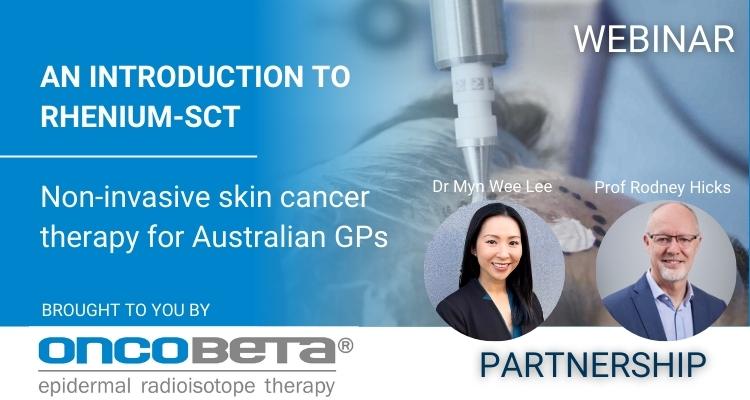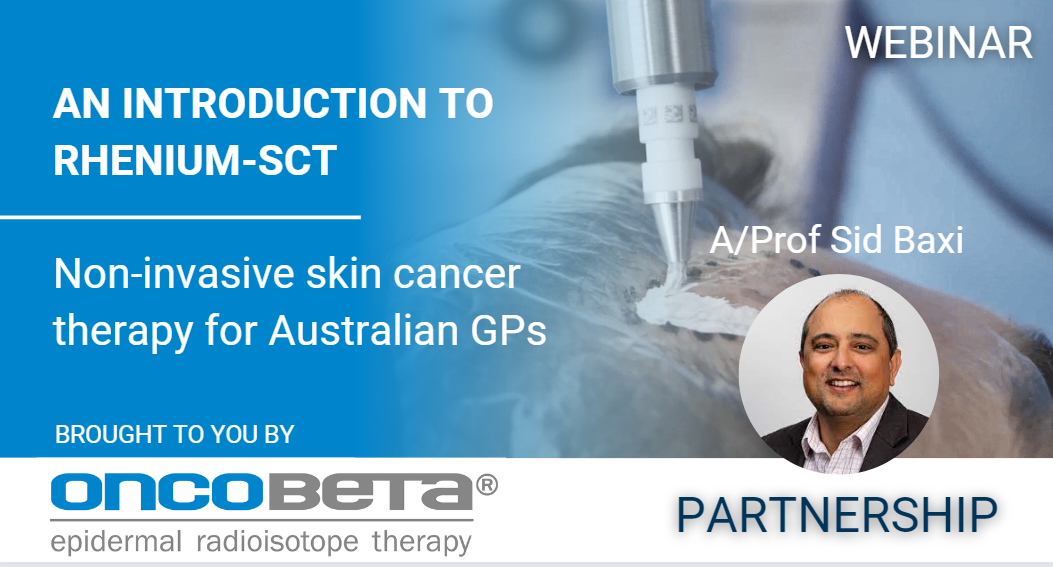Rhenium-SCT non-invasive skin cancer therapy
Watch the full webinar recording from OncoBeta on Rhenium-SCT, the new non-invasive skin cancer therapy in Australia.

HealthCert Education
[1 hour watch] OncoBeta recently presented a fascinating webinar on Rhenium-SCT, the new non-invasive skin cancer therapy in Australia. The full webinar recording is now available below!
Watch full webinar recording now:
Rhenium-SCT is a highly effective treatment for which published studies show a complete remission in 98.5% of all cases, rivalling other non-surgical approaches that sometimes carry the stigma of being less effective than excision.
In the webinar, Dr Myn Wee Lee gives her insights into the innovative and life-changing skin cancer therapy, covering:
- Rhenium-SCT as an alternative to traditional invasive options, designed to provide improved cosmetic outcomes in a painless single-session treatment
- Criteria for patient selection
- The patient experience
- Costs involved
- A comparison to current treatment options
- How this has changed Dr Lee's approach to non-melanoma skin cancers.
In addition, Prof Rodney Hicks provides an overview of the radioactive isotope (rhenium-188) which is based on the local direct cell-killing effect of beta-radiation, which triggers both the local death of cells and local reactions of the immune system of the body to repair itself.
This is a must-watch webinar for all doctors with an interest in skin.
See all this and more in the full webinar above!
Q&A from the webinar
Your top questions answered by Dr Myn Lee.
Is Rhenium SCT affordable for everyone, especially in regional and rural areas?
The advantage of the Rhenium SCT for remote patients is the fact that the treatment can be delivered in a morning, minimising time spent away from home. Compared to a surgical flap or multiple sessions of radiotherapy, ancillary hospital, travel or accommodation costs are avoided or minimised. Clearly, our preference would be that the direct costs of the treatment would be covered by Medicare and the company is in the process of making an application for this to the Medicare Services Advisory Committee to achieve this. However, the radionuclide required for the treatment requires an expensive generator that is made from material that needs to be produced in a nuclear reactor. Both processes are expensive and the material is imported from Germany and then dispensed from the ANSTO facility at Lucas Heights in Sydney. These costs unfortunately need to be passed on to all patients, not just those from rural or remote areas.
Do you need also to consider deep margin – under the skin lesion, and if so, the max depth of 3 mm is with the margin or the thickness of the lesion only?
3mm is maximum thickness of lesion, however for a lesion of 3mm in thickness we would treat with two sessions instead of one. Our radiation licence at the Melbourne Theranostic Innovation Centre restricts us to only treating lesions <3mm of thickness. Pretreatment shaving can render some thicker lesions suitable for treatment but it isn't suitable for very deep lesions.
Would Rhenium SCT be appropriate for cancer excised with inadequate margins instead of wider excision?
Yes, inadequately excised tumours can be treated with Rhenium. We always discuss the option of wider surgical excision as well as alternatives such as conventional radiotherapy.
Do you have any statistics on infection post-treatment?
Avion Skin Centres has established a prospective registry to record this and as providers of this treatment, the clinician group has established a forum at which we share results, both positive and negative of the treatments we deliver.
Any large sample size trial demonstrating superiority in efficacy vs. simply tumour resection?
As I mentioned, most of the available data comes from patients excluded from conventional treatment and who were treated on compassionate grounds. If simple resection is feasible we would indeed recommend it. The main goal is to avoid complex or disfiguring surgery or radiotherapy that might be less convenient for patients or is technically challenging.
You mentioned micronodular BCC and 5mm margin peripherally. For high risk BCC pathologies is it sufficient? What margins do you use for nodular vs infiltrative?
Treatment margins are similar to normal surgical resection margins. 4mm for lower risk NMSCs (e.g. nodular BCCs), 6mm or more for higher risk NMSCs. For an infiltrative BCC we may use 6-8mm margins. Always be guided by clinical information and your assessment on the day.
How often are the follow-up visits? And how arduous are the dressings for these patients?
4 weeks, +/- 6 weeks (depending on how the wound looks like at week 4), then a review at 3 months to ensure the wound has healed well and there is no evidence of skin cancer. Patients usually do not need a dressing, they mainly need to keep the wound as dry as possible for the first 4 weeks.
Without histology, how do we know that the lesion was treated adequately?
As with current topical therapies such as Imiquimod, and also methods such as PDT and conventional radiotherapy where there is no subsequent histology available, these patients need to be reviewed by a doctor trained in dermoscopy with close inspection of the lesion to ensure there is no recurrence. If there is any doubt at all at follow up visits then a biopsy should be performed.
What do we know about recurrence rates?
As explained in the webinar, this treatment has a relatively short history of use and therefore long-term outcome data are not available. However, in a series of 52 patients published last year (See: Cipriani, C. et al. Personalized irradiation therapy for NMSC by rhenium-188 skin cancer therapy: a long-term retrospective study. J Dermatol Treat 33, 969–975 (2022)) no recurrences or severe adverse events were reported.
How much does it cost? // How much do you charge patients? // How much do patients pay for this treatment?
It depends on the number of lesions and size of lesions treated. Avion Skin Clinics can provide quotes prior to treatment. The costs of initial consultations and evaluation are covered by Medicare or private insurance.
Is it covered by private insurance?
Not to our knowledge but it is worth patients with private insurance approaching their insurer as the cost of this treatment may cost the insurer the same of less than covering surgery or radiotherapy. Safety net reimbursement may also limit direct financial burdens on patients.
How do you calculate the radiation dosage?
The radiation dose used in earlier trials was 50Gy to the entire lesion. Because most of the beta particles deposit al their energy in the first 1-2mm, treating lesions at deeper levels needs either more radioactivity to be applied to the foil or for it to be left on for a longer time. For thin lesions, less activity, less time or both are needed. Estimating the amount of radioactivity that needs to be painted on to achieve a reasonable irradiation time is a technical skill but we have generally painted it on thickly enough for 50Gy to be delivered in 60-90 minutes. There is an FDA- and TGA-approved software program that integrates the area treated with the desired depth of treatment and the measured amount of administered activity using a sophisticated calibration of the radioactive ampoule before and after painting to determine the duration that the foil remains on the skin. Emerging data from Italy suggests that excellent disease control rates with faster healing can occur using 35Gy, especially for thin low-risk lesions or in areas of potential risk to adjacent structures.
Are there any special considerations in patient selection and in post-procedure nursing care for genital lesions?
There is very limited data on the use of this treatment for genital SCC. There is a small report from 2013 which involved 15 patients, of which 12 healed, 1 was lost at follow-up and 2 did not respond to therapy (see: Carrozzo, A. M., Sedda, A. F., Muscardin, L., Donati, P. & Cipriani, C. Dermo beta brachytherapy with 188-Re in squamous cell carcinoma of the penis: a new therapy. Eur J Dermatol 23, 183–188 (2013)) In the current era, ultrasound of inguinal nodes and FDG PET/CT would be recommended to firstly exclude regional or distant metastasis. We currently do not have approval for its use in genital SCC but we are considering seeking approval to do a pilot trial in patients who have contraindications to definitive radiotherapy or who wish to avoid surgery such as penectomy. Wound care would pose similar challenges for all types of therapy in this region.
None of these looked too difficult to me for usual treatment. Did you get options from plastics and rad/onc before treating? These would have all been pretty simple.
Most, if not all patients who present to us come after having had multiple consults with dermatologists / plastic surgeons / radiation oncologists, and are very well educated about potential treatment outcomes. At their consultation we again take them through all their treatment options, including a comprehensive discussion about Rhenium. Patients then make an informed decision about their treatment.
As someone who has worked in a major radiation oncology centre, I am always amazed by the discordance between what radiation oncologists and surgeons perceive to be simple and well tolerated by their patients and what patients themselves experience. Based on my relatively modest personal experience of talking to patients after having received this treatment and to a radiation oncologist who has a larger and longer experience as part of the prospective trial run by Oncobeta, this treatment is extremely well tolerated with the main issue being anxiety when the lesion appears to be getting worse rather than better around 4 weeks post-treatment. With education about what to expect and detailed wound care instructions, patients seem very comfortable with reassurance through this period and are generally delighted with the outcome.
What about long term scarring?
Patients can most commonly expect some pigment changes, possibly mild textural changes to skin after 3 months. If patients pick their scabs or infection occurs there is an increased risk of scarring, as there would be for any wound. With good wound care, it seems that the cosmetic results are excellent from report of those involved with this treatment in Europe.
Any risk of radiation to doctor or nurse while applying Rhenium?
All the staff delivering this treatment undergo detailed training and are licenced to handle radioactivity. Time, distance and shielding principles are applied to minimise radiation exposure to staff. We have personal dose meters and being primarily a beta particle emitter, there is very low radiation dose to us.
I disagree with the last slide suggesting surgery is contraindicated in patients who require a skin graft. I also disagree with RH's suggestion that the previous patient would lose his ear in an excision. Had they been referred to an MDT with a plastic surgeon to assess?
Notwithstanding the fact that the patient was 94, had experienced multiple prior surgeries for NMSC and refused to contemplate further surgery, the option of surgical resection was discussed. With the thickness and extent of the lesion and its location, cartilage-conserving surgery with skin grafting or a flap would have been extremely unlikely to have given as a good a result as achieved in his case. The author of this question is entitled to their opinion of whether or not non-mutilating surgery would have been possible or appropriate, we didn't. At the end of the day, the patient was delighted with the outcome and that is what patient-centred care is all about, not turf battles.
For thick lesions above 3mm, can it be treated in several attempts?
Two treatment sessions recommended, or aim to shrink the tumour size enough so that surgery will require a smaller repair. As above, we are not currently licenced to treat lesions more than 3mm in thickness but debulking or sequential treatments make sense.
Would using alpha particles suggest that shallow penetrance will result in a high likelihood of recurrence in high risk lesions when margins cannot be guaranteed? It seems that if margins cannot be adequately assessed, recurrence will mean operating in an irradiated field with high risk of infection, poor healing, and long recovery.
We are not using alphas which pass only 1-4 cells diameters. This was the initial type pf treatment used in the early 1900s (radium-226) and, indeed, multiple serial applications were needed over and relatively long period to gradually get to sufficient depth to have control cancer cells at depth. I have experience of using radionuclide therapy as a neoadjuvant treatment in other settings, for example reducing the bulk of pancreatic neuroendocrine tumours of the pancreas and the feedback that I have received from surgeons is that there is much less desmoplastic reaction with radionuclide therapy than they see with external beam radiotherapy. This possibly relates to a much lower dose rate. Failure rates and need for reoperation seems to be very uncommon anyway if patients are appropriately selected and treatment is performed by well-trained individuals.
Interestingly, a few RCTs have shown that topical antibiotics have no effects on post-operative infection rates. Why topical mupirocin?
This is not prescribed to prevent post-op infection rates, it is prescribed as a safety net. Many patients come from very far away and are unable to return for follow-up at short notice if they have any concerns. They are usually only commence this after a discussion with us about any wound concerns. The ointment formulation also helps soften any thick scabs.
Depigmented skin and scarred skin are more prone to skin cancer. Any evidence of skin cancers emerging? How long has there been follow-up?
Not long but many of these patients have had many solar keratoses or other NMSCs treated before they come to be considered for this treatment and many are quite old. Knowing whether there is a de novo second cancer versus a local recurrence would be difficult but neither seem to have occurred with any meaningful frequency over the relatively short follow-up of most patients reported in the literature.
Considering the punch biopsy is not reliable for assessing the neurovascular involvement, how would you estimate that it is a safe treatment to go ahead with?
If there is any clinical suspicion it is recommended several punch biopsies be collected from the same lesion to improve diagnosis. Neuropathis pain can be a clinical guide to perineural infiltration and in more advanced cases can be visualised on MRI.
Is a radiotherapy technician required for dosage ? Is the calculation of dose and time for rhenium application calculable as a simple application/program?
There is a software algorithm. The process needs to be supervised by a nuclear medicine physician or radiation oncologist with brachytherapy experience but the radioactivity needs to be received and disposed of by a nuclear medicine department with appropriate licences in place. A nuclear medicine technologist is involved in the measurement of the activity applied to each lesion by calibrating activity in the ''carpule'' before and after painting and entering all the required parameters into the computer software that calculates the duration that the foil need to remain in situ.
You haven't spoken about the cost, accessibility in our area and how we can set it up in our major skin cancer clinic? Do we have to refer them to the third party?
The first and significant cost are the highly sophisticated instruments used to paint the rhenium-188 onto the foil and the specific calibration unit. Next is the consumable cost of the rhenium-188 carpules. Since more than one lesion can generally be treated out of a carpule, there are some economies of scale. Transportation of the generator and licencing fees may also impact costs differently depend on country and locale.
Would your clinic assess patients via telehealth for interstates for suitability?
Yes, we have already assessed and treated a number of interstate patients, usually with the help and input of their local skin cancer expert. The initial follow-up consults (for wound assessment) can also be conducted via telehealth.
Your published follow-up studies are too short and from the studies I saw a lot of patients lost to follow-up. Need at least 5 years. One study talked about clearance at 6 months, that is pretty meaningless. Especially if based on clinical assessment alone. Need to do prospective studies with control group and randomisation. Are they planned? I am surprised you are happy to prescribe this outside of a trial with so little data.
The Australian users of this treatment are all passionate about evidence and agree that prospective data are required and for this purpose a detailed registry is being kept, including clinical photographs and regular follow-up. However, for several reasons, randomisation is not a practical option for many patients and may not be as valuable as real-world data in patients treated on compassionate grounds.
With recurrent tumours we move up the therapeutic ladder not down. So if excision fails re-excision would be far preferred.
Yes re-excision is an option but not always the best or most feasible option.
I have a number of patients who have had topical radiotherapy >20 years ago. Typically cosmetic results are good initially, but over time get more vascular and tissue changes making scarring worse. Is this still the case with Rhenium? Would there be an age limit that you would advise against Rhenium?
I am not sure what kind of topical radiotherapy you are referring too as this treatment hasn't been available for that long. I have certainly seen late skin effects and sarcomas developing in prior external beam radiotherapy fields.
Medico-legally have you spoken to indemnity insurances?
With all treatments, the risks and benefits of any treatment, especially relatively new ones needs to be explained to the patient and informed consent needs to be sought and received. Both Oncobeta and MTIC obtain signed consent and both are covered by appropriate indemnity insurance.
Is it an appropriate technique for perineural invasion biopsy proven cancer?
We have spoken to a leading treating physician in Germany about this in particular. For very small perineural invasion (<0.1mm), in thin tumours (within our 3mm cut off) we can still treat with Rhenium. There is a possibility of damaging the nerve involved, which are usually small superficial cutaneous nerves, this may result in minor altered sensation post treatment. Wider margins are also included in these cases. Patients are fully consented.
Clinically significant perineural involvement would normally be treated with external beam radiotherapy or neural sacrifice at surgery in the hope of getting a clear margin. My experience is mainly with desmoplastic melanoma on the face and know that is often very difficult to predict have far it has spread.
What is your informed consent process? What do you tell them re cure rates and long term side effects? Do you think it is a good idea to promote directly to the public before proper trials done?
Of course we have a discussion about what is known with respect to complications and cure rates in the short-term (the first 12-months) and what is unknown about longer-term outcomes. Trials have been done that were sufficient to convince the European Medicines Agency, Federal Drug Administration and Therapeutic Goods Administration to licence the treatment for clinical use. The concept that the only ''proper'' trail is a randomised one is flawed in the populations most likely to benefit from this treatment and long-term follow-up outcomes are somewhat irrelevant to patients in their 80s and 90s.
He would not have lost his ear with surgery either. That ear SCC may yet come back to bite him. That was a high risk lesion.
He and we were willing to take that chance at 94 years of age. I would too. If it was going to metastasize, it has probably already done so and will need treatment on its merits if nodal or systemic metastases become manifest in his lifetime. And if it recurs locally, retreatment by excision or further Re-188 RCT remains an option.
In addition to electron there is also less penetrating photons used in so-called superficial or othovoltage radiotherapy, surgery and post-operative radiotherapy.
We are fully aware that there are many and varied treatments for skin cancers, and the majority of patients referred to Dr Lee are actually referred for alternative treatments. We are not advocating this for all SCCs and BCCs, only carefully selected cases.
Please let us know addresses of the relevant clinics.
In Victoria, the Avion Skin clinics and the treatment delivery at the Melbourne Theranostic Innovation Centre are both located on level 8, 14-20 Blackwood St, North Melbourne.
What is the size of punch bx? 4mm?
3 or 4mm is sufficient, ensure a good depth of the lesion is sampled.

 1800 867 1390
1800 867 1390-1.jpg)
.jpg)




